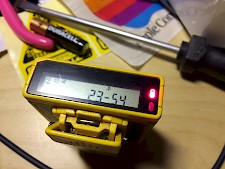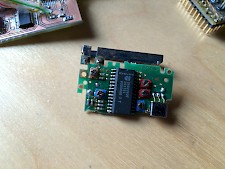Resurrection?
After moving a few times, I found it again a couple of months ago, and decided to see if I could make it work once more. A few years ago, CallMax decided the cost of keeping these numbers alive was too expensive, especially since no-one really paged anymore. Understandable, but kind of disappointing for me. Even worse: after a while, the pager blinked its led once every couple of seconds, and the display showed a little icon indicating there was no reception. Back when it worked, I remember putting the pager in a steel pot to see if I could get that indication to show. It wouldn't; but now it did all the time. Crap. At first, I thought the pager was broken. It had been sitting in a parts box for years, and I wouldn't be totally surprised if it was. Or, maybe the callmax frequency was dead. Time to open up the pager and see what was going on.

The pager containts 2 small pcb's. 1 PCB seems to contain the display controller and main processor, and the other is the radio board. I think the reasoning behind this was ease of production; pagers for different frequencies are easier to produce if you produce an optimized radio board for a specific frequency and a generic processor board for every pager. The radio board is fairly straightforward. Its workhorse is the UAA2080T, an integrated POCSAG radio and decoder IC. POCSAG is the standard used by many pagers worldwide. Other standards like ERMES and FLEX were developed, but the majority of pagers in the Netherlands seem to be of the POCSAG variety. (Except for Flex P2000 for emergency services) Due to its age, the IC is of a fairly large size, and can easily be probed using a scope. Among the many signals are 2 fairly interesting ones, namely ' receiver enable' and the 'data out'. In order reduce battery consumption, the radio receiver is switched off most of the time, and has a idle duty cycle of about 5%. As soon as the pager picks up it's training sequence of 1's and 0's, it leaves the receiver on until a syncword is recognized.
My RTL-SDR told me the frequency is still alive occasionally with some data (frequency can be found on the crystal on the receiver board), but my pager did not seem to extends its listening frame when it was hit with the training sequence (101010101010...........), and the no-signal indicator remained on. Weird eh? Until I looked at the scope and checked timings. Seems CallMax is only transmitting on 1200 baud, whereas my pager is expecting data at 2400 baud. I suppose there aren't many pagers around anyway, let alone Philips Maxers at 2400 baud.
Well there's your problem.
